Nervous System Organization + General Function
1/203
There's no tags or description
Looks like no tags are added yet.
Name | Mastery | Learn | Test | Matching | Spaced |
|---|
No study sessions yet.
204 Terms
The basic functional units of the NS system are called
neurons
The organs that make up the NS are made up of
nervous tissue, as well as supporting blood vessels and connective tissues.
Neural tissue includes supporting cells that are called
neuroglia, or glial cells
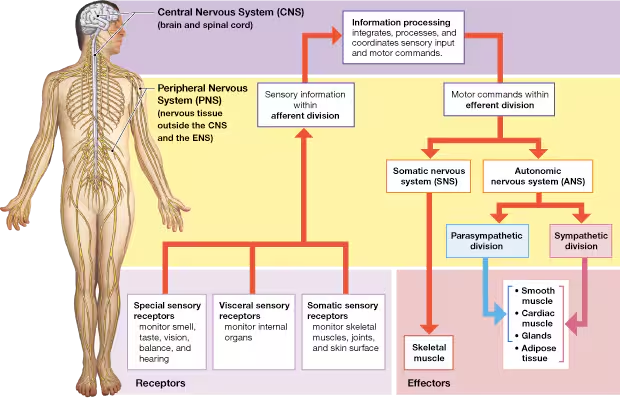
What are the 3 divisions of the NS?
Viewed anatomically, the nervous system has three divisions: the central nervous system the peripheral nervous system, and the enteric nervous system
What does the CNS consist of?
Brain & Spinal Cord. These complex organs include not only nervous tissue, but also blood vessels and the various connective tissues that physically protect and support them.
What does the PNS consist of?
The peripheral nervous system (PNS) includes all the nervous tissue outside the CNS and the ENS.
What are the 2 subdivisions of the PNS?
There are two subdivisions of the PNS: the somatic nervous system and autonomic nervous system.
What is the function of the CNS?
It is responsible for integrating, processing, and coordinating sensory data and motor commands.
What information does sensory data convey? What about motor commands?
Sensory data convey information about conditions inside or outside the body. Motor commands control or adjust peripheral organs, such as skeletal muscles.
When you stumble, which division of the nervous system integrates information about your balance and the position of your limbs and then coordinates your recovery by sending motor commands to appropriate skeletal muscles—all in a split second and without your conscious effort?
CNS
the _____ is the seat of higher functions, such as intelligence, memory, learning, and emotion.
brain
The PNS delivers sensory information to the CNS and carries motor commands to peripheral tissues and systems, except those of which nervous system division?
the enteric nervous system.
What are bundles of axons called? What do they do and in what division of the nervous system are they in?
Nerve fibers; carry sensory information and motor commands in the PNS
Bundles of axons, called nerve fibers, carry sensory information and motor commands in the PNS. Such bundles, with associated blood vessels and connective tissues, are called what type of nerves, or simply nerves.
peripheral nerves
What are nerves connected to the brain called? What are nerves attached to the spinal cord called?
Cranial nerves, spinal nerves.
T/F: The CNS does not have separated functional divisions like the PNS.
T
T/F: The PNS does not have separated functional divisions like the CNS.
F, other way around, the CNS does not have separated functional divisions like the PNS, which is divided into afferent and efferent divisions
The PNS is divided into different divisions called the afferent and efferent divisions. What does each refer to and do?
The afferent division (afferens, to bring to) of the PNS brings sensory information to the CNS from receptors in peripheral tissues and organs. The efferent division (effero, to bring out) of the PNS carries motor commands from the CNS to muscles, glands, and adipose tissue.
Which division of the PNS carries motor commands from the CNS to muscles, glands, and adipose tissue?
Efferent division
Which division of the PNS brings sensory information to the CNS from receptors in peripheral tissues and organs?
Afferent division
What are receptors?
Receptors are sensory structures that either detect changes in the environment (internal or external) or respond to specific stimuli.
Our receptors range from the slender cytoplasmic extensions of single cells to complex receptor organs, such as the eye and ear. Sensory receptors may be neurons or specialized cells of other tissues.
The efferent division (effero, to bring out) of the PNS carries motor commands from the CNS to muscles, glands, and adipose tissue. These target organs, which respond by doing something, are called
effectors.
The efferent division has two divisions called
The somatic nervous system (SNS) and autonomic nervous system (ANS)
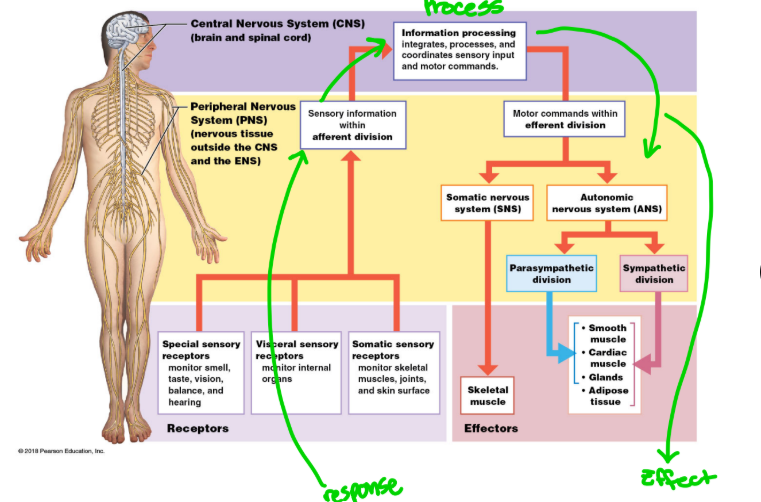
What is the sensory function of the nervous system?
Receiving incoming information (stimuli) from sensory receptors)
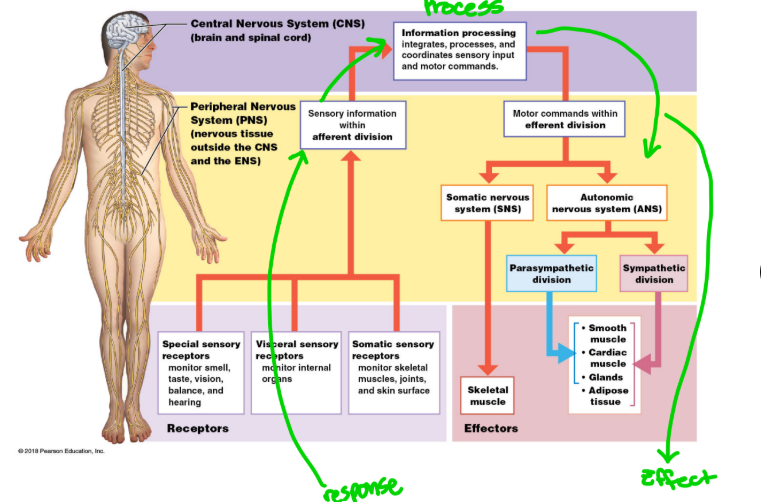
What is the integrative function of the nervous system?
Interpreting and processing information to determine the appropriate response
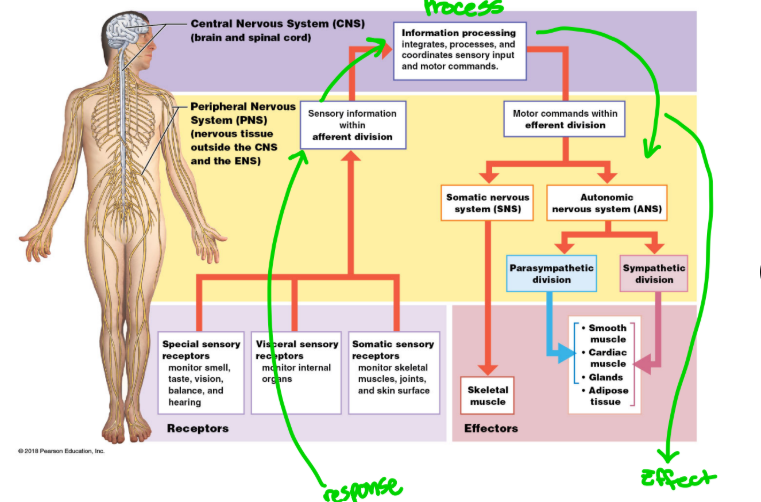
What is the effector function of the nervous system?
Producing outgoing signals to initiate a response in muscles (skeletal, smooth, cardiac) or glands.
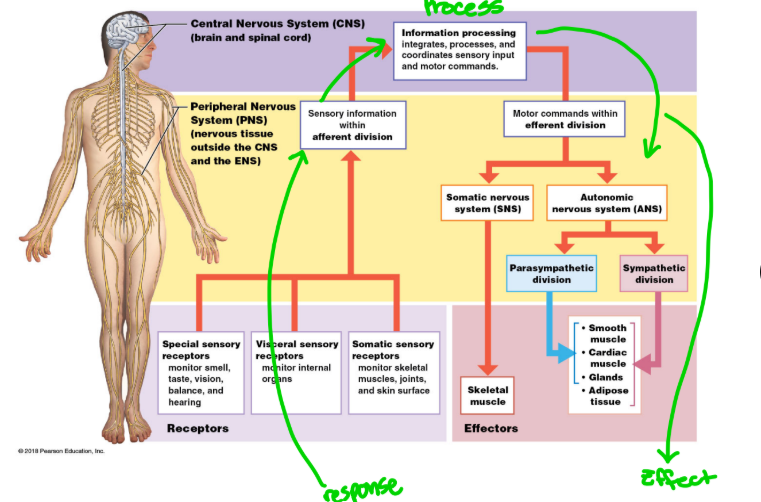
Sense → Process → effect, which are the general functions of the NS, are called what cycle?
Homeostatic cycle
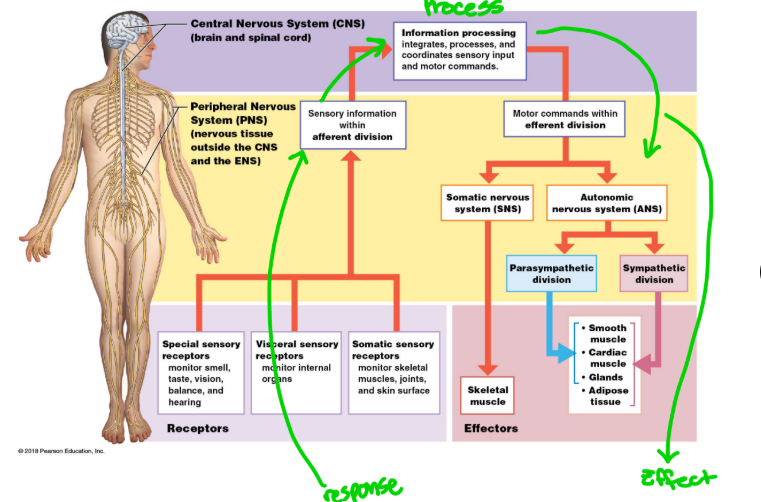
What is the function of the CNS (brain and spinal cord)?
Information processing. Integrates, processes, and coordinates sensory input and motor commands.
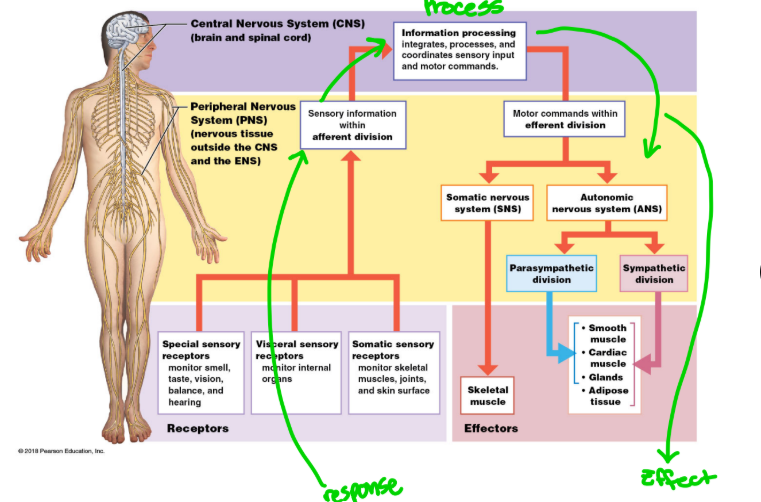
The receptors consist of what 3 types?
Special sensory receptors: monitor smell, taste, vision, balance, and hearing
Visceral sensory receptors: Monitor internal organs
Somatic sensory receptors: Monitor skeletal muscles, joints, and skin surface
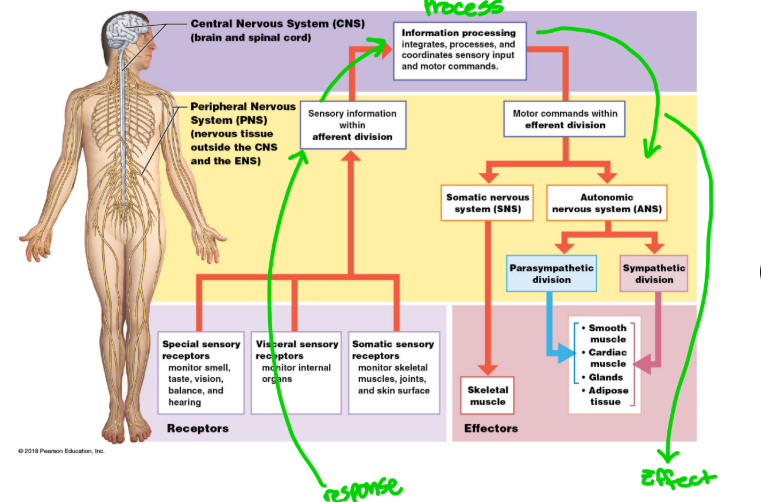
Motor commands happen within what division, and what division of the NS is this located?
Efferent division in the PNS

Nervous tissue outside the CNS and the ENS is what division of the NS?
PNS
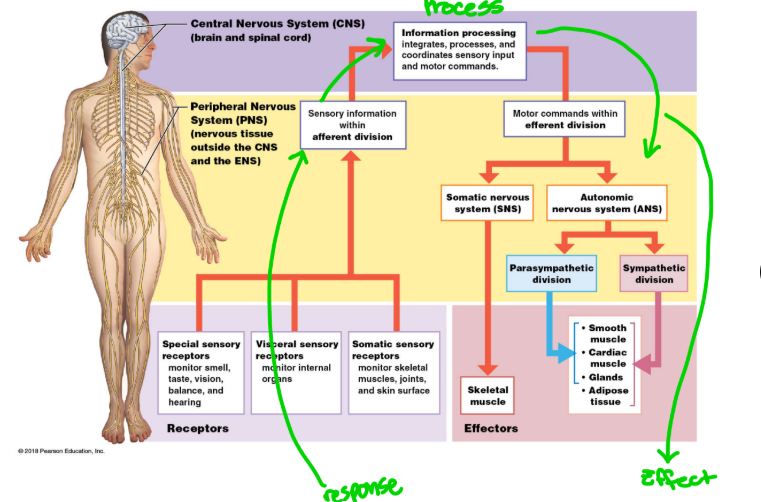
Sensory information happen/get relayed to what division, and what division of the NS is this located?
Afferent division, PNS
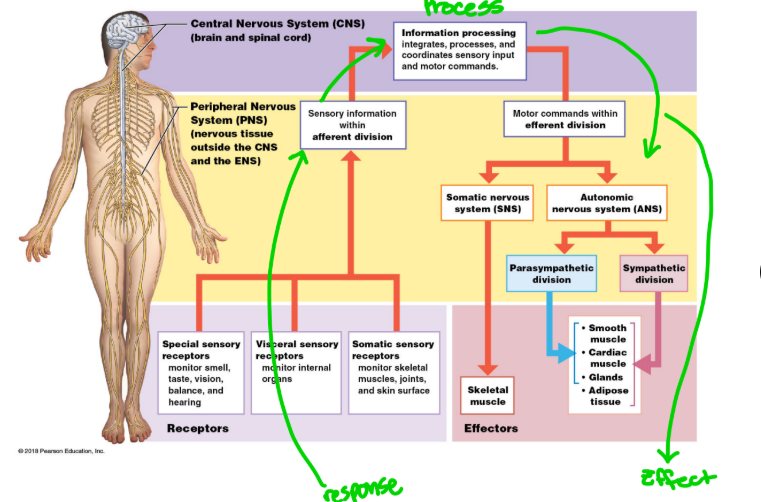
Motor commands happen within the efferent division, which divides into what systems?
Somatic Nervous System (SNS)
Autonomic Nervous System (ANS)
What are the two primary divisions of the NS?
CNS and PNS
Neural tissue, everything outside the CNS, is the
PNS
Where is the CNS contained?
Within the skull and vertebral column to protect the CNS (brain + spine)
The CNS is integrative in function, meaning
It processes and interprets sensory information to make decisions and coordinate appropriate responses. This includes making sense of our surroundings, formulating thoughts, and managing complex behaviors like memory, consciousness, and emotions, which is distinct from simply receiving sensory input or producing motor output.
Simple reflexes
Complex reflexes
Higher order functions
Memory, learning, and intelligence
Where is the PNS located?
Mostly outside of skull & vertebral column
What nerves are present in the PNS?
Peripheral nerves, consisting of cranial nerves and spinal nerves.
What are the peripheral nerves?
Cranial nerves and spinal nerves
What are peripheral ganglia?
clusters of nerve cell bodies located in the peripheral nervous system (PNS), functioning as synaptic relay stations that transmit information to and from the central nervous system (CNS).
Sensory ganglia
Autonomic NS ganglia (sympathetic, parasympathetic)
Broadly, what does the PNS consist of?
Peripheral nerves
Cranial and spinal nerves
Peripheral ganglia
Sensory ganglia
ANS ganglia (sympathetic, parasympathetic)
Sensory organs of vision, hearing, etc.
What division brings sensory information FROM receptors?
Afferent division
What division carries motor commands to effectors?
Efferent division
The efferent division divides into what additional systems?
Somatic nervous system (SNS) to skeletal muscles
Autonomic nervous system (ANS) to cardiac muscle, smooth muscle, glands
Sympathetic
Parasympathetic
What are neurons?
Electrically active cells that process and conduct information in the form of electrical signals
What are neuroglia? What are they in the PNS and CNS?
Support cells.
PNS: Schwann cells, satellite cells
CNS: Oligodendrocytes, astrocytes, microglia, ependymal cells
Schwann cells produce
myelin sheath
satelitte cells and astrocytes, types of glial (support cells) assist with
chemical regulation
How do microglia and ependymal cells, types of neuroglia (glial cells) help support cells?
Microglia clean up the environment, and ependymal cells open up the environment.
Neuroglia only differ in
location
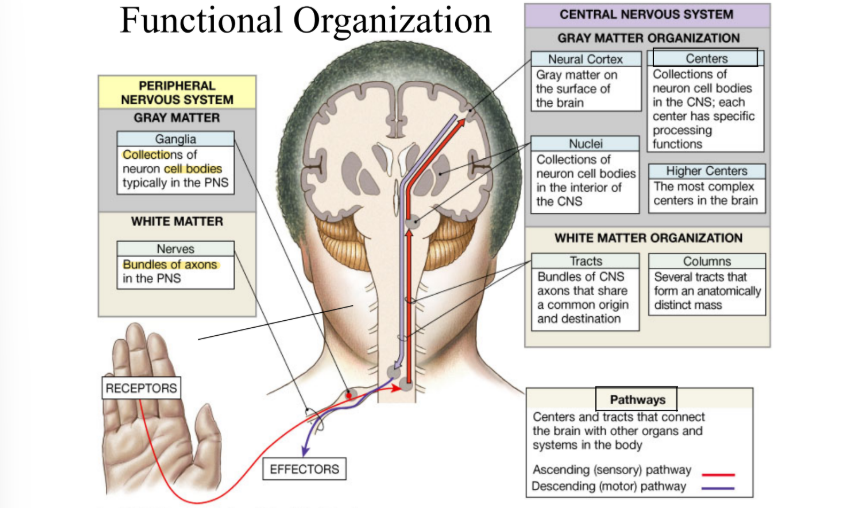
What type of matter are ganglia located in in the PNS?
Gray matter
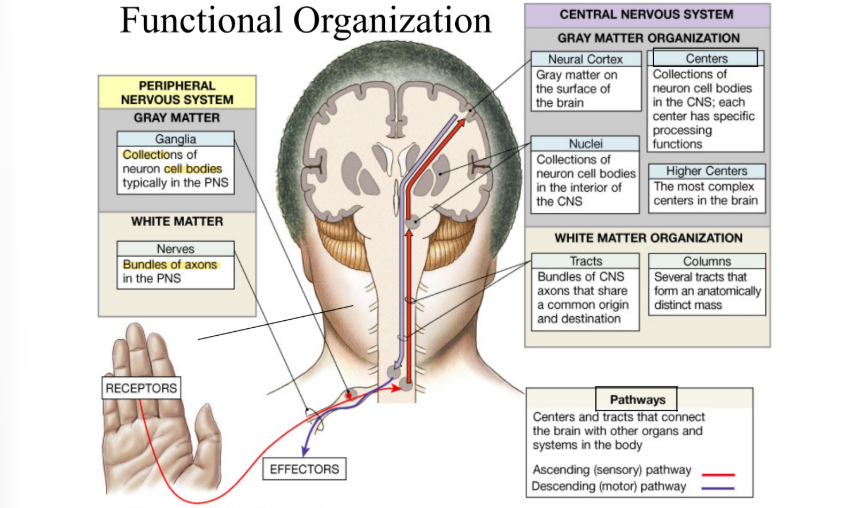
What type of matter are ganglia located in in the CNS?
White matter
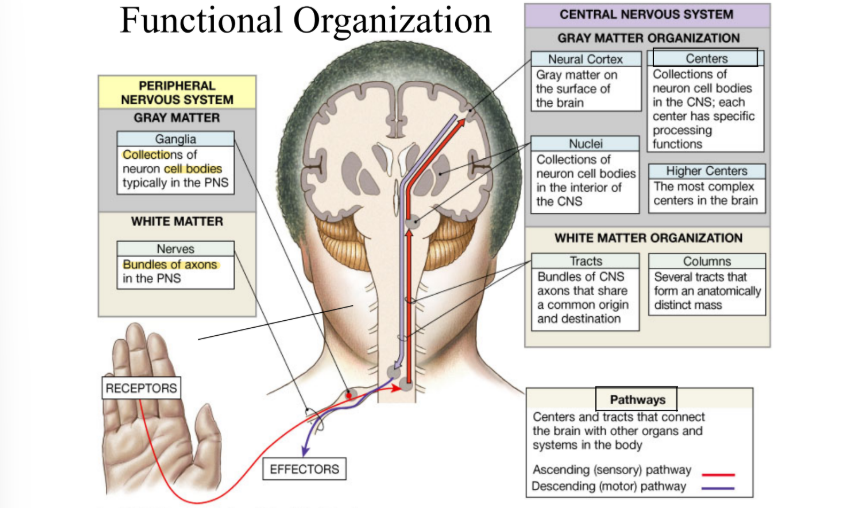
What is ganglia?
Collections of neuron cell bodies typically in the PNS
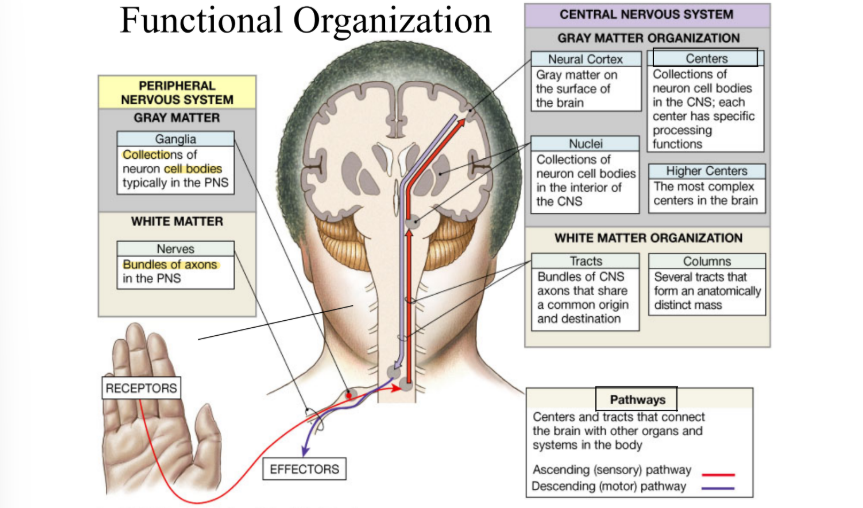
What are nerves?
Bundles of axons in the PNS
The collection of nerve cell processes (fibers, the long extensions of neurons (mostly axons) that carry electrical signals) for the transmission of information in the PNS are
nerves
In the Peripheral Nervous System (PNS), these bundles are called nerves — they connect the CNS to the rest of the body (muscles, skin, organs).
Example: the sciatic nerve carries signals between your spinal cord and your leg.
In the Central Nervous System (CNS) (brain + spinal cord), these bundles are called tracts, columns, or white matter — they carry information within the brain and spinal cord.
Example: the corticospinal tract carries motor commands from your brain down to your spinal cord.
The collection of nerve cell processes (fibers, the long extensions of neurons (mostly axons) that carry electrical signals) for the transmission of information in the CNS are
white matter, fiber tract, column, or fasciculus
In the Peripheral Nervous System (PNS), these bundles are called nerves — they connect the CNS to the rest of the body (muscles, skin, organs).
Example: the sciatic nerve carries signals between your spinal cord and your leg.
In the Central Nervous System (CNS) (brain + spinal cord), these bundles are called tracts, columns, or white matter — they carry information within the brain and spinal cord.
Example: the corticospinal tract carries motor commands from your brain down to your spinal cord.
The collection of nerve cell bodies for the processing of information in the PNS are called
ganglia
The collection of nerve cell bodies for the processing of information in the CNS are called
grey matter, nucleus, cortex
T/F: Neuroglial cells surround and support both nerve cell bodies and processes.
T

T/F: Neuroglial cells surround and support only nerve cell bodies like ganglia in the PNS and grey matter, nucleus, and cortex in the CNS
F. They surround and support both nerve cell bodies and processes.
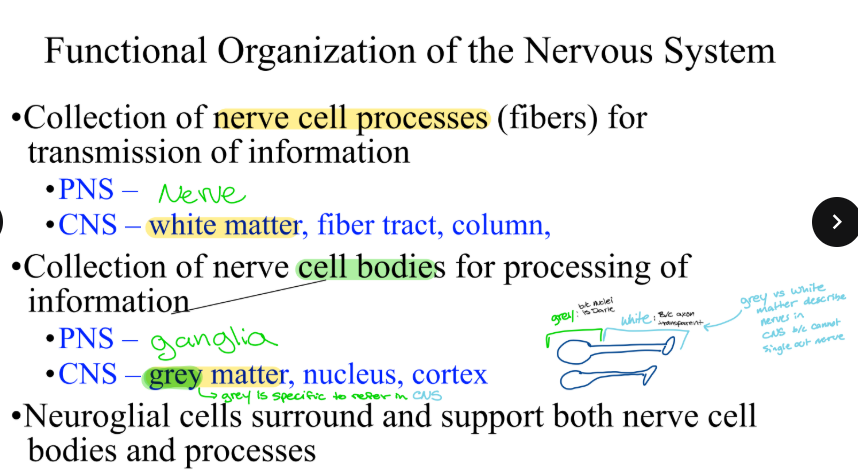
T/F: Neuroglial cells surround and support only nerve cell processes like nerves in the PNS and white matter, fiber tract, column in the CNS
F. They surround and support both nerve cell bodies and processes.
What does the grey matter of the spinal cord consist of? What does grey matter do?
Processing and integration.
Posterior (dorsal) gray horns contain somatic and visceral sensory nuclei
Anterior (ventral) gray horns deal with somatic motor control
Lateral gray horns contain visceral (ANS) motor neurons
The size of grey matter (# of nerve cells) is related to the
size of body area innervated. This means that the amount of gray matter (which contains the neuron cell bodies) in a section of the spinal cord depends on how much muscle control or sensory input that body region needs.
If a body area requires more precise movement or sensation, it needs more neurons, so the gray matter there will be larger.
Example: Your hands and fingers need fine motor control → more neurons → larger gray matter in the cervical region.
These are specific places in the spinal cord where the gray matter bulges out (is enlarged) because they serve the limbs.
Cervical and lumbar enlargements
In grey matter, posterior (dorsal) gray horns contain what?
somatic and visceral sensory nuclei
In grey matter, anterior (ventral) gray horns deal with what?
with somatic motor control
T/F: Posterior (dorsal) gray horns deal with sensory processing and integration in the grey matter of the spinal cord, whereas anterior (ventral) gray horns deal with somatic motor processing and integration (skeletal muscles) in the grey matter of the spinal cord.
T
T/F: Anterior (ventral) gray horns deal with sensory processing and integration in the grey matter of the spinal cord, whereas posterior (dorsal) gray horns deal with somatic motor processing and integration (skeletal muscles) in the grey matter of the spinal cord.
F. Other way around!
Posterior (dorsal) gray horns deal with sensory processing and integration in the grey matter of the spinal cord, whereas anterior (ventral) gray horns deal with somatic motor processing and integration (skeletal muscles) in the grey matter of the spinal cord.
In grey matter of the spinal cord, lateral gray horns contain what?
visceral (ANS) motor neurons, the autonomic nerve system
The white matter of the spinal cord is divided into six columns containing tracts. The columns are also called ____ and consist of what columns?
funiculi; posterior, anterior, and lateral columns
What is the function of the white matter in the spinal cord?
Transmission of information
What is the difference between functions of the white and grey matter of the spinal cord?
White: Transmission of information
Grey: Processing and integration
The white matter is made up mostly of myelinated axons (nerve fibers covered with myelin), which are specialized for what functions?
transmitting information quickly — not processing it. So its main job is communication — sending signals up and down the spinal cord.
The white matter is organized into regions (columns or “funiculi”) on each side of the spinal cord:
Posterior (dorsal) columns – at the back
Lateral columns – on the sides
Anterior (ventral) columns – at the front
Inside each column are tracts, which are bundles of axons carrying to same type of information. What is the difference between ascending and descending tracts?
Ascending tracts → carry sensory information upward
From the body → spinal cord → brain
(e.g., touch, temperature, pain signals)Descending tracts → carry motor commands downward
From the brain → spinal cord → muscles
(e.g., brain sending signals to move your arm)
The adult spinal cord is a single continuous structure with 31 spinal cord “segments”defined by spinal nerves (8C, 12T, 5L, 5S, 1Co etc) (the letters stand for cervical, thoracic, lumbar, sacral, coccygeal). The dorsal (posterior) root of spinal nerve is _____ whereas the ventral (anterior root) of spinal nerve is _____
sensory (afferent), motor (efferent)
Spinal nerves are a mixture of what fibers?
sensory & motor fibers
Each spinal nerve receives sensory input from one ______.
dermatome. A dermatome is a specific area of skin that sends sensory input to one spinal nerve.
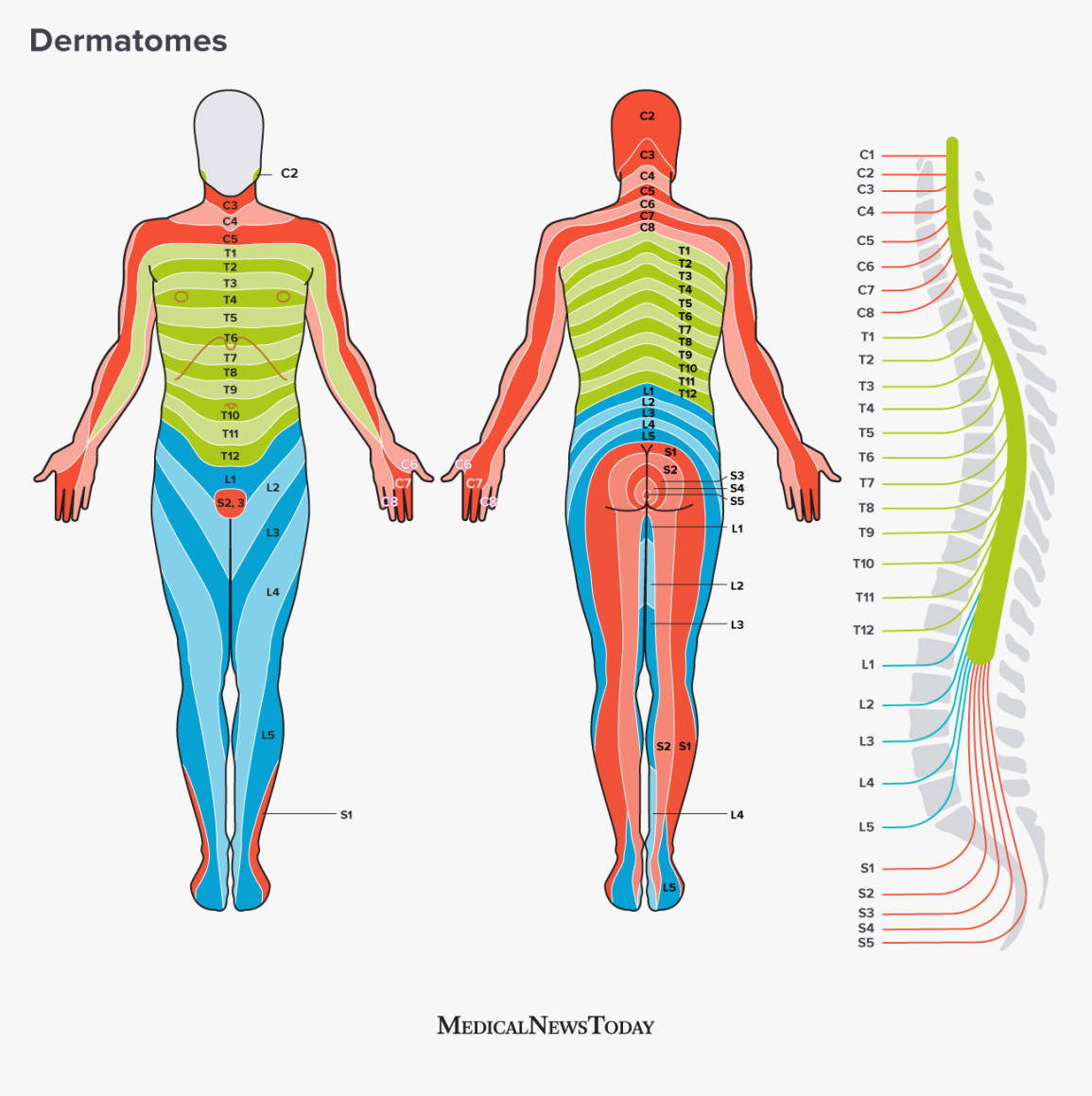
What is a dermatome?
A dermatome is a specific area of skin that sends sensory input to one spinal nerve. Each spinal nerve receives sensory input from one dermatome.
T/F: Each spinal nerve receives sensory input from multiple dermatomes.
F. It is ONE dermatome.
Another term that describes cells that function as afferents of the CNS is
sensory neuron
Match the following major regions in the adult brain and brainstem
Telencephalon
Diencephalon
Mesencephalon
Metencephalon
Myelencephalon
-
Medulla Oblongata
Pons and cerebellum
Midbrain
Thalamus & Hypothalamus
Cerebrum or cerebral hemispheres
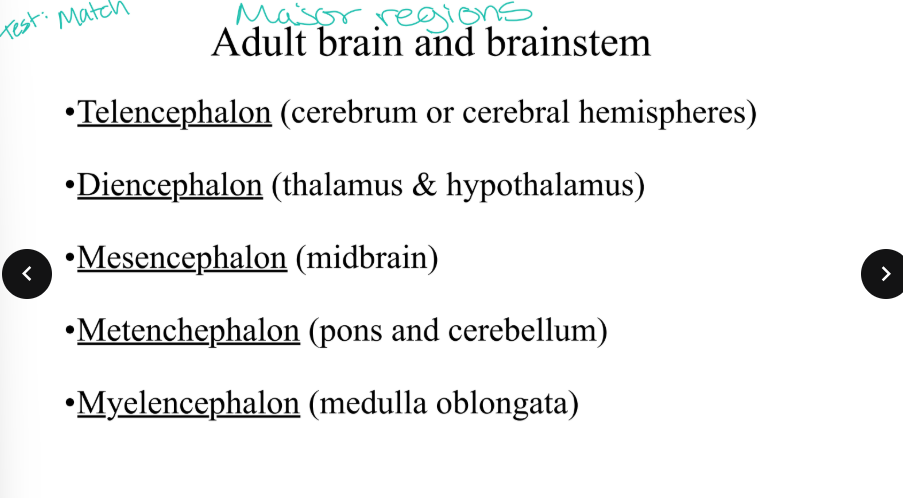
In the grey matter of the brainstem and brain (processing and integration), the cortex of cerebral hemispheres (cerebrum) is responsible for
the highest level of processing
In the grey matter of the brainstem and brain (processing and integration), the basal nuclei of cerebral hemispheres is responsible for
motor control
In the grey matter of the brainstem and brain (processing and integration), the thalamus is responsible for
processing sensory information
What does the diencephalon consist of
Thalamus, hypothalamus
In the grey matter of the brainstem and brain (processing and integration), the hypothalamus is responsible for
ANS & Endocrine (hormones) control
In the grey matter of the brainstem and brain (processing and integration), the cortex of cerebellum is responsible for
Motor control
Various brainstem nuclei are located where?
In the grey matter of the brainstem and brain (processing and integration)
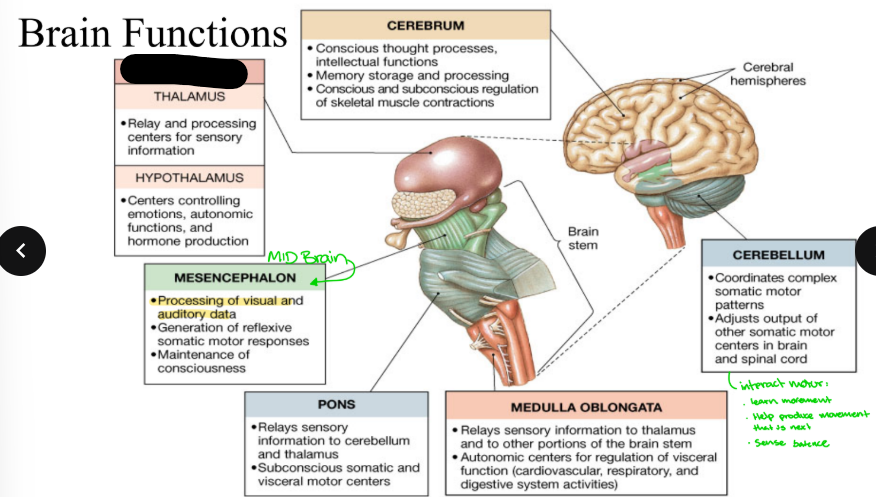
What part is blacked out?
diencephalon
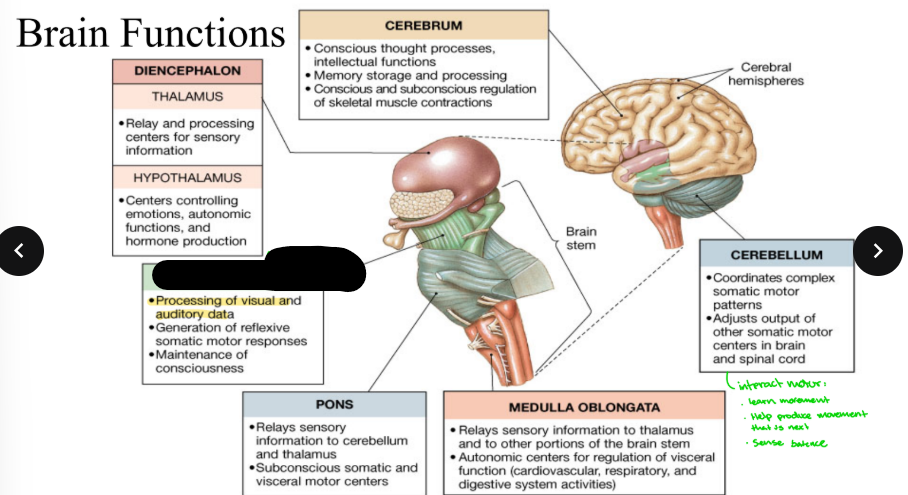
What part is blacked out?
mesencephalon (midbrain)
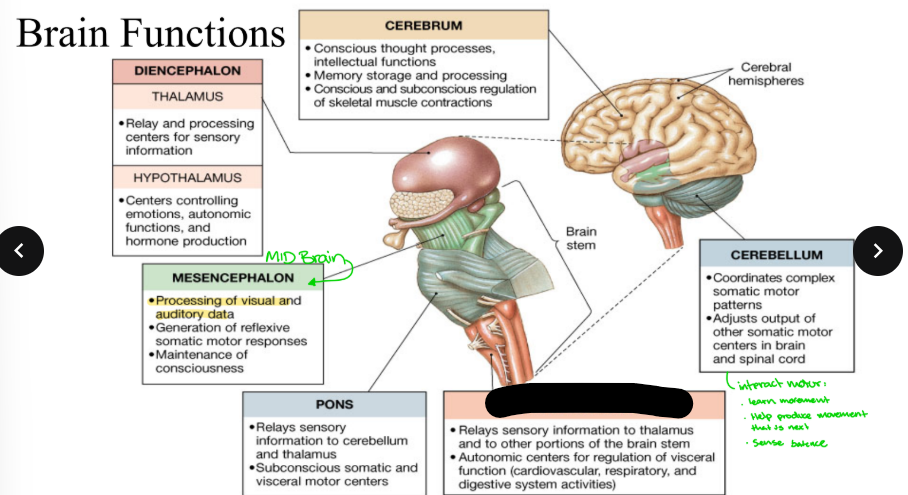
What part is blacked out?
medulla oblongata
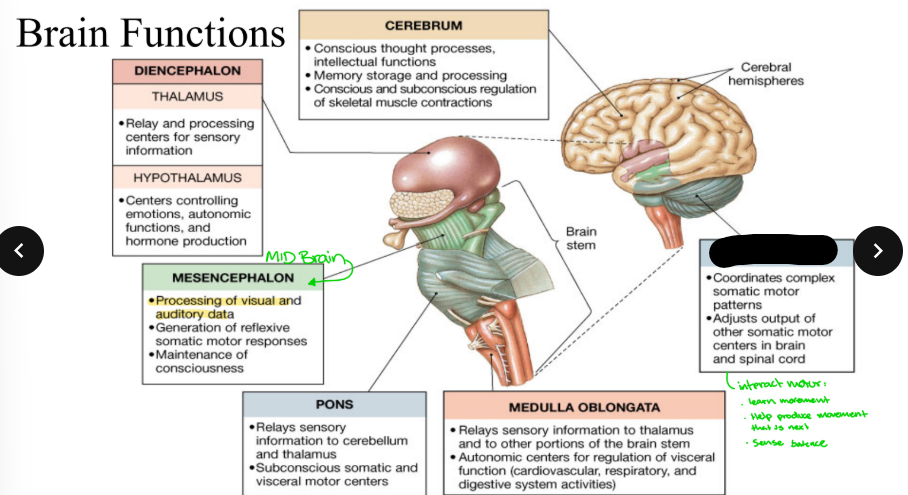
What part is blacked out?
cerebellum
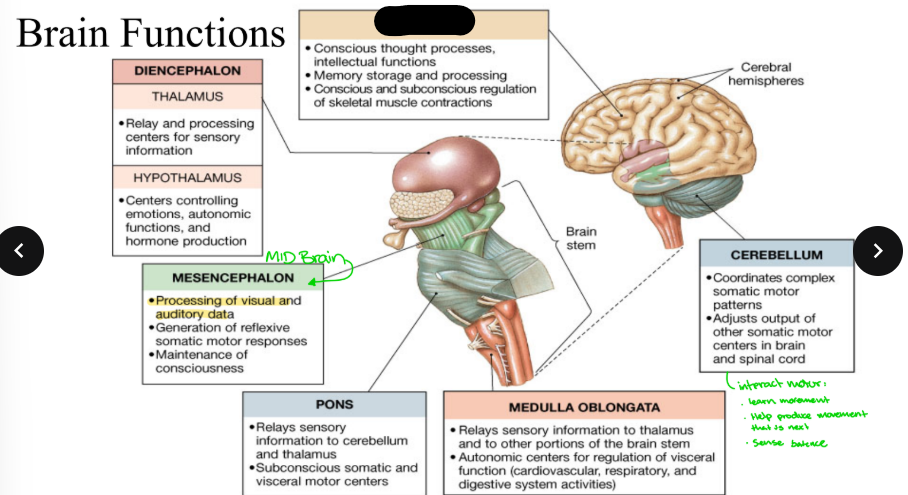
What part is blacked out?
Cerebrum
The midbrain is formally known as
the mesencephalon
The mesencephalon is also known as
the midbrain
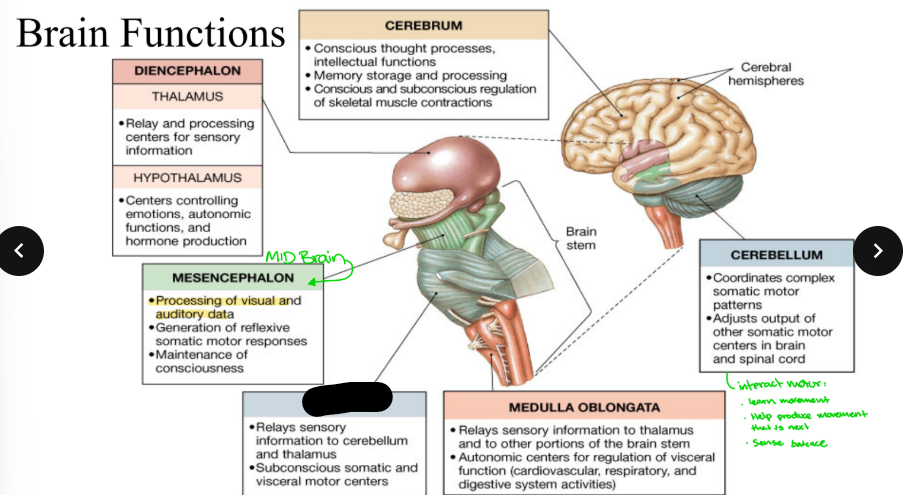
What part is blacked out?
pons

ascending and descending tracts (afferent + efferent pathways) of the spinal cord, brain stem, and brain in the white matter transmitting information are called
projection fibers

What are projection fibers?
ascending and descending tracts (afferent + efferent pathways) of the spinal cord, brain stem, and brain in the white matter transmitting information. connect the cortex with lower brain regions or spinal cord
The white matter of the brainstem and brain consist of what 3 things?
Projection fibers
Association Fibers
Commissural fibers
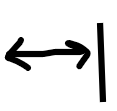
What are association fibers?
a type of white matter fiber in the brain that connect between areas on the same side of the CNS